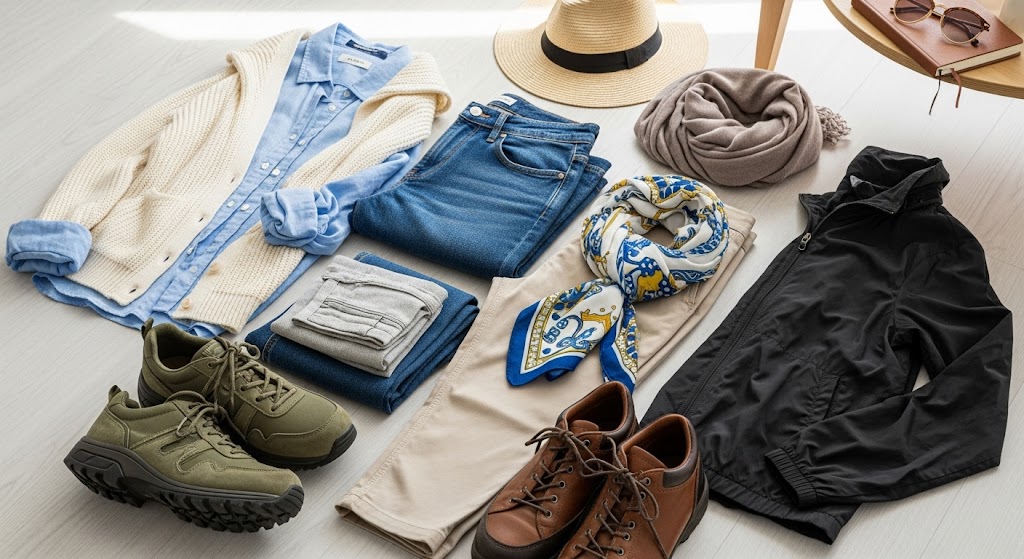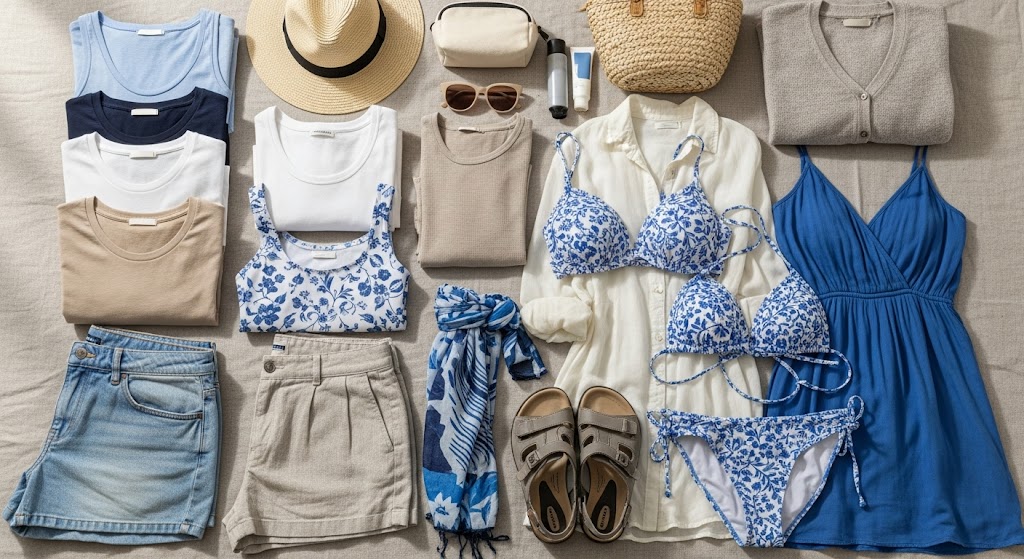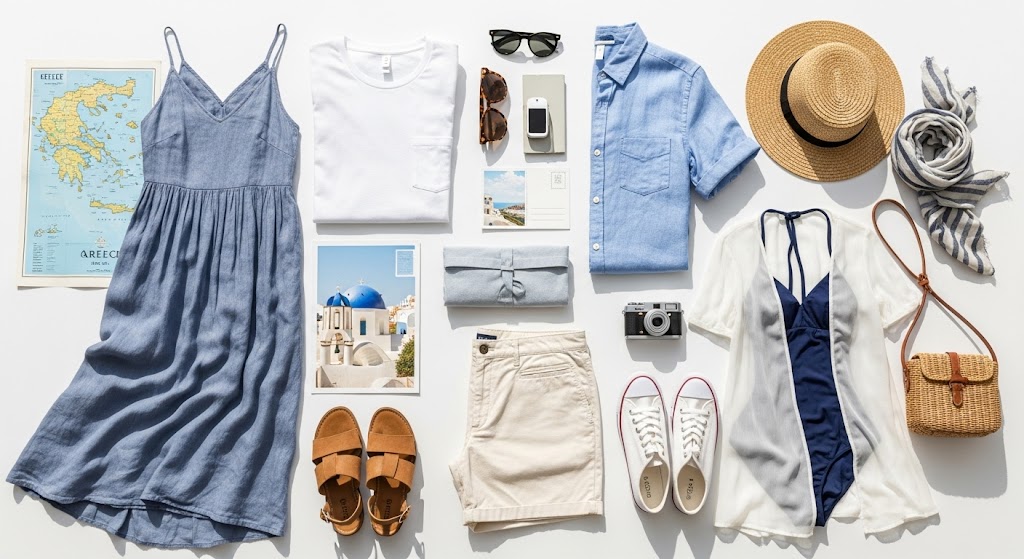Packing for Greece leaves many travelers confused about what clothes to bring.
You know you’ll be island hopping, exploring ancient temples, and enjoying Mediterranean beaches, but Greece’s climate varies drastically between destinations and seasons.
I’ll solve your packing dilemma with a complete guide to dressing appropriately for any Greek adventure.
You’ll learn which fabrics work best in scorching summer heat, how to layer for unpredictable spring weather, and what footwear handles both cobblestone streets and sandy beaches.
This guide breaks down outfit recommendations by season, essential wardrobe pieces for different activities, and specific clothing tips for both men and women visiting Greece.
Weather in Greece: What to Expect Before You Pack?
Greece’s climate varies significantly depending on when and where you visit.
Summer temperatures range from 75-90°F (24-32°C) with hot, dry conditions perfect for delicate fabrics. Spring and fall bring mild 60-75°F (15-24°C) weather that’s ideal for layering.
Winter drops to 45-60°F (7-15°C) and gets rainy, especially on the mainland. The Greek islands stay warmer year-round compared to Athens or northern cities.
Strong Mediterranean winds called Meltemi blow during summer months, making temperatures feel cooler but requiring secure hats and scarves.
Intense sun and low humidity mean you’ll need sun protection even in cooler months, while coastal areas stay breezy and comfortable.
Season-Based Outfits for Activities in Greece
Greece’s diverse climate means your packing list changes dramatically depending on when you visit. Here’s what to wear for each season’s unique weather patterns and popular activities.
1. Spring & Fall

The mild weather during these seasons makes them perfect for exploring Greece comfortably.
You’ll spend hours walking through archaeological sites during warm afternoons, then dine outdoors as temperatures drop after sunset.
You’ll need versatile pieces that work for both scenarios and can handle light rain showers.
These are the must-have items that will keep you comfortable while exploring ancient ruins during the day and dining al fresco as temperatures drop:
- Lightweight sweaters or cardigans for layering
- Long pants or jeans for walking tours
- Jacket or windbreaker for evenings
- Closed-toe shoes for hiking to ancient sites
- A scarf or pashmina for chilly nights
Pro Tip: Bring a lightweight scarf or shawl that doubles as a blanket for ferry rides. Greek island ferries can get unexpectedly cold from sea spray and air conditioning.
2. Summer

Greece’s summer heat calls for the softest, most breathable clothing you own.
You’ll be walking through archaeological sites, lounging on beaches, and dining outdoors until late evening. Focus on natural fabrics that keep you cool while protecting your skin from intense UV rays.
Your summer wardrobe should prioritize comfort and sun protection without sacrificing style for evening dining and beach clubs. Include these essential items :
- Cotton or linen t-shirts and tank tops
- Lightweight shorts and sundresses
- Lightweight rompers that work for both beach and boardwalk
- Sandals with arch support for walking
- Wide-brimmed hat and sunglasses
- Soft cardigan for air-conditioned restaurants
Pro Tip: Choose light colors that reflect heat, and always pack one dressy outfit for upscale tavernas and beach clubs.
3. Winter

Winter in Greece means rain, wind, and cooler temperatures that require proper layering. You’ll move between heated indoor spaces like museums and cafes, then step outside to explore chilly archaeological sites.
The weather changes quickly, and sudden downpours are common, especially in coastal areas and on the islands.
These are the winter essentials that will handle Greece’s unpredictable weather while keeping you warm and dry during museum visits and outdoor sightseeing:
- Warm sweaters and long-sleeve shirts
- Waterproof jacket or coat with a hood
- Sturdy boots with non-slip soles
- Pants and thermal layers
- Wool socks and gloves
- Umbrella for sudden rain showers
Pro Tip: Pack clothes you can easily add or remove. Greek buildings often have inconsistent heating, so you’ll be adjusting layers frequently.
Essentials to Not Miss in Your Greek Wardrobe
Building the perfect Greek wardrobe means focusing on versatile pieces that work across multiple activities and weather conditions. Given below are the essential clothing categories every traveler should pack.
- Tops – Pack breathable cotton t-shirts for hot days and weightless blouses for evening dining. Button-down shirts work perfectly for both casual sightseeing and dressier occasions.
- Bottoms – Comfortable shorts are essential for summer heat, while long trousers protect your legs during cooler months. Flowy skirts offer both comfort and style for exploring ancient sites.
- Dresses – Sundresses keep you cool during hot weather and look polished for dinner. Midi dresses work for both day tours and evening activities, while sweater dresses handle cooler temperatures.
- Layers – Light jackets and cardigans are lifesavers when temperatures drop unexpectedly. Pashminas serve double duty as style accessories and warmth for air-conditioned spaces.
- Shoes – Sturdy walking shoes with a good grip are non-negotiable for cobblestone streets and ancient ruins. Pack comfortable sandals for hot days and boots for winter visits.
- Swimwear & Accessories – Quality swimsuits and quick-dry cover-ups are essential for beach days. Don’t forget polarized sunglasses, lightweight scarves, and secure crossbody bags for hands-free exploring.
Men’s Clothing Guide for Greece
Greek men dress well without being overly formal. Focus on classic, well-fitted pieces that work from beach to taverna.
- Cotton button-down shirts in white, blue, or neutral tones
- Well-fitted chino shorts and long pants for both casual and dressy occasions
- Quality polo shirts that breathe well and look polished
- Lightweight swim trunks for beach days
- Fair sweaters and blazers for cooler evenings
- Canvas sneakers for walking tours and flip-flops for the beach
- Baseball cap or Panama hat for sun protection
Women’s Clothing Guide for Greece
Greek women embrace effortless femininity while staying practical for the Mediterranean climate. Focus on flowy, comfortable pieces that transition seamlessly from beach to dinner.
- Maxi dresses in breathable cotton or linen fabrics
- High-waisted shorts paired with crop tops or blouses
- Wrap-style tops that are flattering and versatile
- Palazzo pants for elegant evening dining
- Stylish one-piece swimsuits with matching sarongs
- Strappy sandals with ankle support for long walks
- Delicate jewelry that won’t tarnish in salt air
- Lightweight kimono-style cover-ups for religious sites
Final Thought
Packing for Greece doesn’t have to stress you out anymore. You now know exactly what to wear in Greece for every season, from breathable summer fabrics to warm winter layers.
The key is choosing versatile pieces that work for multiple activities and weather conditions.
Remember to pack one extra layer, choose pastel colors for summer, and always bring comfortable walking shoes.
Greek style is about looking polished while staying practical, so focus on quality basics that mix and match easily.
Ready to start packing? Save this guide and use it as your checklist.
What’s your biggest packing concern for Greece? Share your questions in the comments below. I’d love to help you plan the perfect wardrobe for your Greek getaway!
Frequently Asked Questions
What to Wear to The Acropolis?
Wear comfortable walking shoes with good grip, breathable clothing, a hat, and sunglasses. Avoid flip-flops on marble surfaces as they’re slippery and unsafe.
Is There a Dress Code for the Parthenon?
No formal dress code exists for the Parthenon. However, wear modest clothing out of respect and comfortable shoes for walking on uneven ancient stones.
What do ladies wear in Santorini?
Ladies wear flowy sundresses, lightweight blouses, comfortable sandals, and wide-brimmed hats. Light-colored things work best to reflect heat while exploring the island’s white buildings., while sweater dresses handle cooler temperatures.







